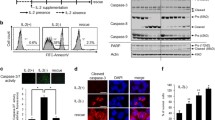Abstract
CERAMIDE is an important regulatory participant of programmed cell death (apoptosis) induced by tumour-necrosis factor (TNF)-α and Fas ligand, members of the TNF superfamily1–6. Conversely, sphingosine and sphingosine-1-phosphate, which are metabolites of ceramide, induce mitogenesis7 and have been implicated as second messengers in cellular proliferation induced by platelet-derived growth factor and serum8,9. Here we report that sphingosine-1-phosphate prevents the appearance of the key features of apoptosis, namely intranucleosomal DNA fragmentation and morphological changes, which result from increased concentrations of ceramide. Furthermore, inhibition of ceramide-mediated apoptosis by activation of protein kinase C results from stimulation of sphingosine kinase and the concomitant increase in intracellular sphingosine-1-phosphate. Finally sphingosine-1-phosphate not only stimulates the extracellular signal-regulated kinase (ERK) pathway10, it counteracts the ceramide-induced activation of stress-activated protein kinase (SAPK/JNK). Thus, the balance between the intracellular levels of ceramide and sphingosine-1-phosphate and their regulatory effects on different family members of mitogen-activated protein kineses determines the fate of the cell.
Similar content being viewed by others
References
Hannun, Y. A. J. biol. Chem. 269, 3125–3128 (1994).
Kolesnick, R. & Golde, D. W. Cell 77, 325–328 (1994).
Heller, R. A. & Krönke, M. J. Cell Biol. 126, 5–9 (1994).
Obeid, L. M., Linardic, C. M., Karolak, L. A. & Hannun, Y. A. Science 259, 1769–1771 (1993).
Cifone, M. G. et al. J. exp. Med. 177, 1547–1552 (1994).
Gulbins, E. et al. Immunity 2, 1–20 (1995).
Spiegel, S. & Milstien, S. J. Membr. Biol. 146, 225–237 (1995).
Olivera, A. & Spiegel, S. Nature 365, 557–560 (1993).
Coroneos, E., Martinez, M., McKenna, S. & Kester, M. J. biol. Chem. 270, 23305–23309 (1995).
Wu, J., Spiegel, S. & Sturgill, T. W. J. biol. Chem. 270, 11484–11488 (1995).
Jarvis, W. D. et al. J. biol. Chem. 269, 31685–31692 (1994).
Jayadev, S. et al. J. biol. Chem. 270, 2047–2052 (1995).
Cifone, M. G. et al. EMBO J. 14, 5859–5868 (1995).
Gill, B. M., Nishikata, H., Chan, G., Delovitch, T. L. & Ochi, A. Immun. Rev. 142, 113–125 (1994).
Tepper, C. G. et al. Proc. natn. Acad. Sci. U.S.A. 92, 8443–8447 (1995).
Haimovitz-Friedman, A. et al. J. exp. Med. 180, 525–535 (1994).
Jarvis, W. D., Turner, A. J., Povirk, L. F., Traylor, R. S. & Grant, S. Cancer Res. 54, 1707–1714 (1994).
Bornfeldt, K. E. et al. J. Cell Biol. 130, 193–206 (1995).
Derijard, B. et al. Cell 76, 1025–1037 (1994).
Kyriakis, J. M. et al. Nature 369, 156–160 (1994).
Westwick, J. K., Bielawska, A. E., Dbaibo, G., Hannun, Y. A. & Brenner, D. A. J. biol. Chem. 270, 22689–22692 (1995).
Verheij, M. et al. Nature 380, 75–79 (1996).
Dudley, D. T., Pang, L., Decker, S. J., Bridges, A. J. & Saltiel, A. R. Proc. natn. Acad. Sci. U.S.A. 92, 7686–7689 (1995).
Crespo, P. et al. J. biol. Chem. 269, 21103–21109 (1994).
Xia, Z., Dickens, M., Raingeaud, J., Davis, R. J. & Greenberg, M. E. Science 270, 1326–1331 (1995).
Zhang, H. et al. J. Cell Biol. 114, 155–167 (1991).
Duke, R. C. & Cohen, J. J. in Current Protocols in Immunology (suppl. 3) (eds Coligan, J. E., Kruisbeek, A. M., Margulies, D. H., Shevach, E. M. & Strober, W.) 3.17.1–3.17.16 (Green/Wiley, New York, 1992).
Olivera, A., Rosenthal, J. & Spiegel, S. Analyt. Biochem. 223, 306–312 (1995).
Yatomi, T. et al. Analyt. Biochem. 230, 315–320 (1995).
Coso, O. A. et al. J. biol. Chem. 270, 5620–5624 (1995).
Author information
Authors and Affiliations
Rights and permissions
About this article
Cite this article
Cuvillier, O., Pirianov, G., Kleuser, B. et al. Suppression of ceramide-mediated programmed cell death by sphingosine-1-phosphate. Nature 381, 800–803 (1996). https://doi.org/10.1038/381800a0
Received:
Accepted:
Issue Date:
DOI: https://doi.org/10.1038/381800a0
- Springer Nature Limited
This article is cited by
-
Sphingolipids: drivers of cardiac fibrosis and atrial fibrillation
Journal of Molecular Medicine (2024)
-
A comprehensive multiomics approach reveals that high levels of sphingolipids in cardiac cachexia adipose tissue are associated with inflammatory and fibrotic changes
Lipids in Health and Disease (2023)
-
Ceramide synthase 4 overexpression exerts oncogenic properties in breast cancer
Lipids in Health and Disease (2023)
-
Acid ceramidase gene therapy ameliorates pulmonary arterial hypertension with right heart dysfunction
Respiratory Research (2023)
-
Phase I study of opaganib, an oral sphingosine kinase 2-specific inhibitor, in relapsed and/or refractory multiple myeloma
Annals of Hematology (2023)





